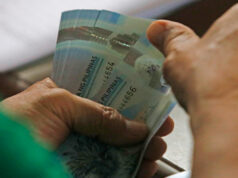Debt yields drop on GDP
YIELDS ON government securities (GS) fell last week following news that the Philippine economy entered a recession, increasing demand for these papers.
Debt yields declined 6.6 basis points (bps) on average week on week, based on the PHP Bloomberg Valuation Service Reference Rates of Aug. 7 published on the Philippine Dealing System’s website.
“The larger than expected contraction in GDP (gross domestic product) spurred buying interest as investors speculate on prolonged economic weakness and increased chances of further BSP (Bangko Sentral ng Pilipinas) action,” ATRAM Trust Corp. Head of Fixed Income Jose Miguel B. Liboro said in an e-mail.
“Dealers and investors alike continued to park funds in the local bond market as the reimplementation to stricter containment measures and… the economy registering a deeper contraction opened a room for speculation of more stimulus needed as the economy officially enters into a recession,” Robinsons Bank Corp. peso sovereign debt trader Kevin Palma said in a Viber message.
The Philippine economy shrank for the second straight quarter, plunging into a recession for the first time in nearly three decades. The second-quarter GDP, which recorded a 16.5% slump, was the biggest contraction on record based on available government quarterly data dating back to 1981, eclipsing the 10.7%. drop in the third quarter of 1984.
For the first half, GDP averaged -9%, lower than the government’s initial expected contraction of 2%-3.4% this year, as well as the later-revised 5.5% decline.
A few days before the GDP results were released, President Rodrigo R. Duterte put Metro Manila, Laguna, Cavite, Rizal and Bulacan back under modified ECQ (MECQ) to slow the rise in COVID-19 cases. The new lockdown began on Aug. 4 and will last until Aug. 18 after exhausted health workers asked for a “timeout” to ease the pressure on the healthcare sector.
“Apart from this, trading activity remained relatively light with most players waiting for the new 5-year retail Treasury bonds (RTB 05-13) to set the tone in the market once it lists [this] week,” Mr. Liboro added.
The RTBs, which were offered in denominations of P5,000, are deemed as low-risk instruments with relatively high yields. These five-year fixed-rate bonds, which were offered until last Friday, will be issued this Wednesday and mature on Aug. 12, 2025. The papers will be listed on the Philippine Dealing and Exchange Corp.
This is the second time the Bureau of the Treasury has offered retail bonds this year. The government raised a record P310.8 billion via three-year RTBs in February — P250 billion in new money or fresh funds and P60.8 billion from the exchange offer program.
At the secondary market last Friday, yields were lower than week-ago levels across all tenors, except for 20-year papers which inched up 5.6 bps to 3.588%.
The yield on the 91-day Treasury bill went down 14.1 bps to 1.288%. The 182- and 364-day papers likewise declined 7.1 bps and 1.5 bps, respectively, to fetch 1.535% and 1.79%.
At the belly of the yield curve, rates of two-, three-, and four-year Treasury bonds (T-bonds) went down 3.5 bps (2.009%), 4.7 bps (2.143%), and 5.4 bps (2.265%), respectively. Yields on the five- and seven-year papers also dropped 6.2 bps (2.381%) and 5.7 bps (2.585%).
At the long end, rates of the 10- and 25-year T-bonds decreased 8.2 bps and 21.8 bps, respectively, to 2.693% and 3.665%.
“Right now, COVID-19 (coronavirus disease 2019) still dictates everything with both health and economic authorities still trying to find the perfect equilibrium,” Robinsons Bank’s Mr. Palma said.
“For the week, local bond yields may trade sideways albeit with downward bias as the market continues to put their excess cash to work,” he added. — Michelle Anne P. Soliman



